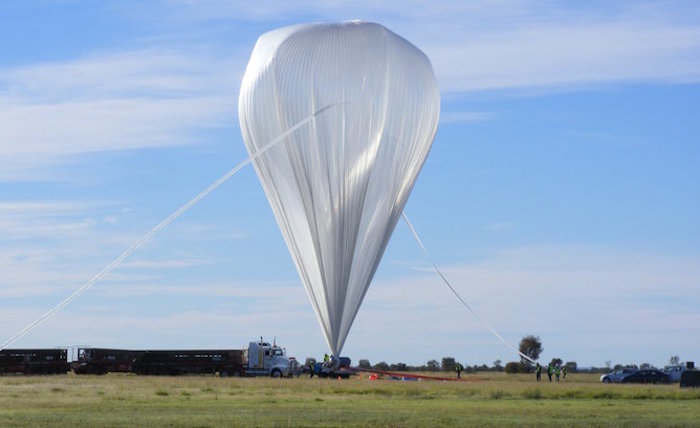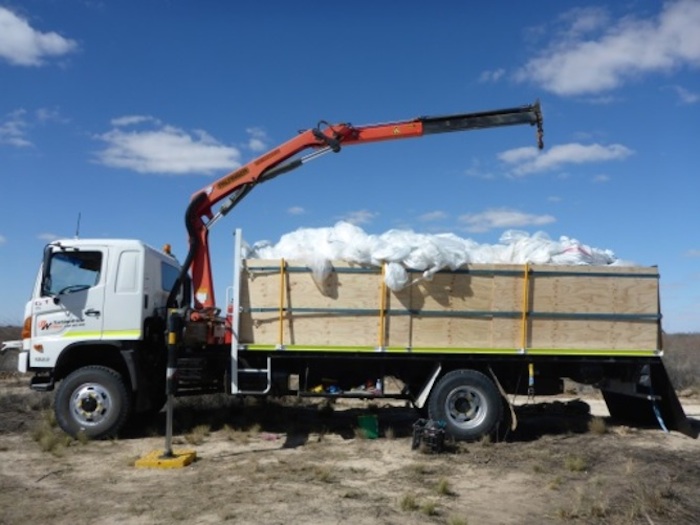.

Giant balloons can take scientific equipment to the edge of space much cheaper that satellites. Ravi Sood, Author provided
.
The giant balloon brought down on a cattle station in remote south-west Queensland in April was part of a NASA mission to test the feasibility of using specialised balloons flown in the stratosphere for scientific research.
While this mission ended in misadventure, these super-pressure balloons have a number of advantages over conventional Earth-orbiting satellites.
For one, they are capable of remaining afloat above 99% of the Earth’s atmosphere for periods of up to six months. They thus provide a vehicle for carrying instruments, mainly in the field of astronomy and astrophysics. And they can do this at a small fraction of the cost of placing such instruments on satellites.
The lead time for such experiments is also dramatically reduced compared to satellite-borne experiments. In addition, a super-pressure balloon can provide an ideal platform for long-term monitoring of the Earth’s atmosphere and environment.
Space age balloons
Super-pressure balloon technology has been under development by NASA, and by the French and Japanese space agencies for nearly two decades. The ultimate goal is to be able to have the capability of carrying instruments weighing up to two tonnes to stratospheric altitudes up to 40km, and keeping them afloat for several months.
If you want to know the size of balloon needed to lift such a weight to stratospheric altitudes, you need only turn to Archimedes' Principle.
The density of air at ground level is 1.3kg/m3, so a balloon of volume 1m3 is able to just lift a mass of 1.3kg. At 40km altitude the air density is 330 times less, so to lift the same mass of 1.3kg to that altitude requires a balloon of volume 330m3.
.

The NASA super-pressure balloon had to lift its own mass (2,268kg) plus the payload (1,588kg), so it had to have a volume of about the size of the Melbourne Cricket Ground.
Most stratospheric balloons are of the “zero-pressure” variety, where the envelop is open at the bottom. This leads to a gradual loss of helium gas, limiting the flight duration.
Despite this limitation, our group – then at Melbourne University – had succeeded in flying such a balloon for 22 days in January 1983 after it was launched from Alice Springs and had circumnavigated the globe.
NASA’s super-pressure balloons are sealed, made of thicker material and have the potential of remaining aloft for several months.
The environment at stratospheric altitudes is harsh though. The temperature is below -20C while the ultraviolet radiation is intense. The tensions in the balloon envelope resulting from the enormous weight that it is carrying can result in deformations and leaks, which is what happened to the latest NASA balloon.
When this happens on a balloon flight in Australia’s airspace, we at UNSW Canberra are required by Airservices Australia to carry out the flight termination so that there is no danger to aircraft during the flight descent. We also have to avoid restricted and inhabited areas for landing, which is what we did with the latest flight.
The rise and fall of the NASA balloon flight
A balloon’s drift cannot be controlled, so the optimum time for flight is when the wind is reasonably predictable in direction and speed.
Stratospheric winds blow strongly in an easterly direction for approximately six months of the year. They then switch around and blow strongly in a westerly direction.
The launch of the NASA super-pressure balloon coincided with the April switch in wind direction. The float winds were expected to take the balloon around the world at approximately the latitude of the launch site of Wanaka, on New Zealand’s south island.
After the launch on March 27 this year the balloon’s performance was excellent and it drifted according to predictions over South America and then South Africa.
A change in direction
But the stratospheric winds over the Indian Ocean developed an unexpected north-south component (see image, below), which eventually led it to drift towards Queensland.
.

When this balloon entered Australian airspace, it became our responsibility to ensure its safe conduct, in compliance with Australian aviation and safety regulations.
I had obtained approval from the Civil Aviation Safety Authority (CASA) to make sure that the flight complied with our regulations, and from Airservices Australia for the procedures to follow for flight termination should this become necessary.
On the morning of April 28, I was informed by NASA that the balloon had developed a leak. Since the projected path would have taken it towards Adelaide, it was decided to terminate the flight while it was over sparsely populated areas.
After seeking approval from Air Traffic Control in Melbourne for the termination time and location, the emergency services in Queensland were alerted to the event.
The flight was terminated at 1:03pm AEST and the payload with parachute impacted on the ground at 1:44pm, 107 km north east of Tibooburra.
The balloon descended separately and landed 10km from the payload.
.


This super-pressure balloon was simply an engineering flight to test the performance of the balloon. A further super-pressure balloon flight is planned by NASA, again from Wanaka in New Zealand but not until 2016.
Other balloon missions
I have been involved in X-ray and gamma-ray astronomy using balloon-borne equipment designed and constructed in my research laboratory. These observations are complemented with other observations from satellite borne and ground-based telescopes.
My current focus is on observing X-rays and optical light from an unusual star system, 2S0114+650, which I believe is of an extremely rare kind. It contains a known super-giant star and an exceedingly dense neutron star in a mutual orbit of 11.6 days.
Our observations of 2S0114+650 seem to indicate that there is a third star in this system, possibly another compact object, with an orbital period of 30.7 days.
Australia has a long history of working with stratospheric balloon flights with more than 130 launches from the Balloon Launching Station in Alice Springs since 1974. I’ve been Station Director of this facility since 1988.
We had a very successful flight last month, involving the Japanese Space Agency JAXA, and there are plans for further flights next year with JAXA, and a campaign involving the French Space Agency CNES, in 2017.
The attraction of Alice Springs is two-fold. It is the centre of a huge tract of sparsely populated countryside, necessary for safe operations.
It is also at a latitude where the centre of our Milky Way Galaxy, home to many objects of astrophysical interest, passes virtually overhead. These objects cannot be seen from the northern hemisphere.
Quelle: The Conversation Trust (UK)
4507 Views
